NOTE al Saggio di Andrzej Kobyli?ski:
Omosessualità e sacerdozio. Il nodo gordiano dei cattolici?
Fonte: [https:]]
1 Andrzej Kobyli?ski ? dopo gli studi compiuti presso la Pontificia Università Gregoriana di Roma, è attualmente professore di Filosofia presso la Facoltà di Filosofia Cristiana dell?Università del Cardinale Stefan Wyszy?ski di Varsavia. Ha pubblicato in italiano diversi articoli ed un libro sotto il titolo Modernità e postmodernità. L?interpretazione cristiana dell?esistenza al tramonto dei tempi moderni nel pensiero di Romano Guardini (1998). E-mail: a.kobylinski@uksw.edu.pl.
2 Cfr. R. Marchesini, Quelli che: «l?omosessualità di un prete non è un problema», in [www.lanuovabq.it] (accesso 17 febbraio 2016). La dichiarazione della propria omosessualità di Krzysztof Charamsa assomiglia, in un certo senso, all?altro spettacolare «coming out» di un teologo cattolico tedesco, David Berger, avvenuta all?inizio del 2010. Berger ha raccontato la storia della sua vita in un libro che subito è diventato un bestseller. Cfr. D. Berger, Der heilige Schein: Als schwuler Theologe in der katholischen Kirche, Berlin 2010.
3 Cfr. Congregazione per il clero, Il Dono della vocazione presbiterale, Città del Vaticano 2016, 83-84.
4 Cfr. J. Boswell, Alla scoperta dell?amore. Cristianesimo e omosessualità, Roma 2015; M. L. Brown, Puoi essere gay e cristiano. Rispondere con amore e verità alle domande sull?omosessualità, Catania 2015; P. Sprinkle, Living in a Gray World: A Christian Teen?s Guide to Understanding Homosexuality, Nashville 2015; B. Brogliato ? D. Migliorini, L?amore omosessuale. Saggi di psicoanalisi, teologia e pastorale. In dialogo per una nuova sintesi, Assisi 2014; M. A. Yarhouse, Homosexuality and the Christian: A Guide for Parents, Pastors, and Friends, Minneapolis 2010; S. Teisa, Le strade dell?amore. Omosessualità e morale cristiana, Roma 2002.
5 Quando non è opportuno ammettere al sacerdozio ? L?intervista al card. Zenon Grocholewski, in 30 Giorni 11 (2005) ? [www.30giorni.it] (accesso 17 febbraio 2016).
6 Per descrivere il rifiuto, parziale oppure totale, del Magistero della Chiesa a proposito dell?omosessualità, il filosofo e teologo polacco Dariusz Oko usa il concetto di «omoeresia». «Ho iniziato il mio lavoro ? sostiene Oko ? come una lotta contro una mortale minaccia esterna al cristianesimo ma, poco a poco, ho scoperto che la divisione fra esterno ed interno non è così facile. L?avversario non è soltanto all?esterno della Chiesa, ma è anche già ben radicato al suo interno, pur se spesso dissimulato come un ?cavallo di Troia?. Il problema dell?omosessualità e della lobby-gay non esiste soltanto all?esterno della Chiesa, ma è ben presente anche al suo interno, dove l?omosessualismo diventa omoeresia» (D. Oko, Con il Papa contro l?omoeresia, in R. Marchesini, Omosessualità e Magistero della Chiesa. Comprensione e speranza, Milano 2013, 159). Cfr. D. Oko, Zehn Argumente gegen die Homosexuellenpropaganda, in Theologisches 43/1-2 (2013) 47-54.
7 Cfr. L. Bertocchi, Che liti e botte tra gli anglicani. Sembrano cattolici ? in [www.lanuovabq.it] (accesso 17 febbraio 2016).
8 M. Ch. Biagioni, Vergogna e dolore della Chiesa di Scozia per la pedofilia, in Agenzia SIR, 24 agosto 2015 ? [agensir.it] (accesso 17 febbraio 2016).
9 Cfr. R. Marchesini, Omosessualità e Magistero della Chiesa, 1-156.
10 San Pier Damiani, Liber Gomorrhianus, traduzione a cura di G. De Antonellis, Roma 2014.
11 Cfr. Sacred Congregation for Religious, Instruction Religiosorum institutio, in Canon Law Digest, v. 5, Milwaukee 1963, 452-486.
12 Nella versione inglese la frase cruciale dell?Istruzione del 1961 suona così: «Advancement to religious vows and ordination should be barred to those who are afflicted with evil tendencies to homosexuality or pederasty, since for them the common life and the priestly ministry would constitute serious dangers» (Instruction Religiosorum institutio, n. 30).
13 Charles Curran è stato considerato non più idoneo né eleggibile ad esercitare la funzione di professore di Teologia cattolica molti anni più tardi, grazie alla decisione presa il 25 luglio 1986 dal card. Joseph Ratzinger, allora Prefetto della Congregazione della Dottrina della Fede.
14 Cfr. Ch. Curran, Christian Morality Today, Notre Dame 1966; iD., Edited Absolutes in Moral Theology?, Washington DC 1968; iD., Absolute Norms in Moral Theology, in In Norm and Context in Christian Ethics, a cura di G. H. outka ? P. raMseY, New York 1968, 139-74; Ch. Curran, A New Look at Christian Morality, Notre Dame 1968; iD., Contemporary Problems in Moral Theology, Notre Dame 1970; iD., Homosexuality and Moral Theology: Methodological and Substantive Considerations, in Thomist 35 (1971) 447-81; iD., Dialogue with the Homophile Movement: The Morality of Homosexuality, in Homosexuality and Ethics, a cura di E. Batchelor, New York 1980, 89-95; Ch. curran, Catholic Moral Theology in Dialogue, Notre Dame 1972; iD., New Perspectives in Moral Theology, Notre Dame 1974; iD., Issues in Sexual and Medical Ethics, Notre Dame 1978; iD., Transition and Tradition in Moral Theology, Notre Dame 1979; iD., Moral Theology: A Continuing Journey, Notre Dame 1982; iD., Critical Concerns in Moral Theology, Notre Dame 1984; iD., Directions in Fundamental Moral Theology, Notre Dame 1985.
15 Cfr. D. kowalczYk, Krzy? gejów [La croce dei gay], in Wprost 10/1006 (2002) 66-68. Nel 2013 Kowalczyk ha parlato del bisogno della difesa del cattolicesimo cosciente della propria identità. Non nominando espressamente alcun problema concreto, incluso quello dell?omosessualità, ha riconosciuto il «pluralismo di fatto» come una sfida vera e propria che va affrontata oggi dal pensiero cattolico. «Viviamo in società sempre più mescolate, ma quando il multiculturalismo è ideologico, imposto da una prospettiva laicista, l?identità di ciascuno non è realmente rispettata. Così noi cattolici siamo chiamati a curare la nostra cattolicità, rendendola contemporaneamente sempre più coraggiosa e sempre più aperta: da un lato una identità forte, dall?altro una grande disponibilità a un dialogo vero» (Il circolo virtuoso della teologia ? Intervista a P. Dariusz Kowalczyk, S.I., in La Gregoriana 45/XVIII (2013) 16). A gennaio 2016, invece, Dariusz Kowalczyk ha criticato fortemente il libro di Adriano Oliva, domenicano italiano del convento di Saint-Jacques (Parigi), intitolato L?amicizia più grande. In contributo teologico alle questioni sui divorziati risposati e sulle coppie omosessuali (Firenze 2015). Secondo Kowalczyk, in questo caso si deve parlare di una vera e propria «eresia omosessuale». Cfr. D. Kowalczyk, Homoseksualna herezja [Eresia omosessuale], in Idziemy, 31 gennaio 2016 ? [idziemy.pl] (accesso 17 febbraio 2016).
16 La versione polacca dell?opinione di Dariusz Kowalczyk del 2002 si presenta così: «Niejasny pozostaje stosunek Ko?cio?a do ujawniaj?cych si? niekiedy w?ród kleryków sk?onno?ci homoseksualnych. Jedni twierdz?, ?e je?li osoba homoseksualna pragnie zosta? ksi?dzem i szczerze chce przyj?? wszelkie wymagania zwi?zane z tym stylem ?ycia, to nie ma powodu, aby z góry uznawa? j? za niezdoln? do kap?a?stwa. Inni uwa?aj?, ?e homoseksuali?ci ? mimo dobrych ch?ci ? nie nadaj? si? do ?ycia w celibacie, poniewa? przebywaj?c zasadniczo w ?rodowisku m?skim, nara?eni s? na nieustanne pokusy, którym pr?dzej czy pó?niej ulegn?. Praktyka w wielu seminariach wydaje si? taka, ?e za dyskwalifikuj?ce uwa?a si? czyny homoseksualne, nie za? sk?onno?ci, do których mo?na si? szczerze przyzna?? (D. Kowalczyk, La croce dei gay, 68).
17 Nella versione originale inglese la parte cruciale del documento del 1985 si presenta nel modo seguente: «A candidate for his homosexually active or whole ads a homosexual lifestyle (whether he is homosexual or not) is not acceptable as a seminarian. Latent or repressed homosexuality is also a counter-indication requiring that the candidate not be accepted ? it would not be faith to the individual nor to the seminary community. [?] We feel that the distinction that has been made in the past between homosexual practice and orientation seems to us to have become blurred, with ?orientation? now allowing of the embrace of an unacceptable ?commitment? to or support of homosexual practices or lifestyles. We prefer to distinguish between practice, orientation and temptation, the first two being counter-indications of acceptability. Temptations may involve or depend on orientations, but we prefer to use the word temptation when the behavioral [sic] impulse, inclination or appetite does not involve the orientation of the kind described above» (Sacred Congregation for Catholic Education, A Memorandum to Bishops seeking advice in matters concerning homosexuality and candidates for admission to Seminary, Roma 1985).
18 G. Ghirlanda, Gli omosessuali e l?ammissione al sacerdozio. Aspetti canonici, in La Civiltà Cattolica 3761 (2007) 436.
19 L?Istruzione Potissimum institutioni, n. 39.20 T. Radcliffe, La promessa di vita. Lettera all?Ordine, 25 febbraio 1998.
21 Cf. G. weigel, The Courage to Be Catholic: Crisis, Reform and the Future of the Church, New York 2002; A. Kobyli?sKi (recensione), Fortunato Di Noto, La pedofilia. I mille volti di un olocausto silenzioso, Milano 2002, Przegl?d Powszechny 7-8 (2003) 228-231.
22 Cfr. M. D?antonio, Mortal Sins: Sex, Crime, and the Era of Catholic Scandal, New York 2013.
23 Cfr. A. greeleY, Bishops Paralyzed over Heavily Gay Priesthood, in National Catholic Reporter 10/11 (1989) 13-19; J. G. wolf, Gay priests, San Francisco 1989; R. McBrien, Homosexuality and the Priesthood: Questions We Can?t Keep in the Closet, in Commonweal 19/06 (1987) 380-383.
24 «The fact is that many qualified candidates for the priesthood have been turned away for political reasons over the past three decades. Systematic, ideological discrimination has been practiced against seminarians who uphold Catholic teaching on sexuality and other issues; dissenters from Catholic teaching ? particularly the Church?s teaching on homosexuality ? have been rewarded. This is the heart of the problem, and an understanding of this fact helps one to answer another burning question: Who is responsible for this state of affairs? The liberal sociologist Father Andrew Greeley has called them the ?Lavender Mafia? a clique of homosexual dilettantes, acting in concert with liberal faculty members who are determined to change the doctrines, disciplines, and mission of the Catholic Church from within. Through the seminaries, this ?Lavender Mafia? has brought a moral meltdown into the Catholic priesthood» (The roots of the scandal July 04, 2002, in CatholicCulture.org ? [www.catholicculture.org] , accesso 17 febbraio 2016).
25 Cfr. R. Weekland, A Pilgrim in a Pilgrim Church: Memoirs of a Catholic Archbishop, Grand Rapids 2009.
26 Cfr. D. Cozzens, The Changing Face of the Priesthood: A Reflection on the Priest?s Crisis of Soul, Minnesota 2000.
27 «The hot-button issue of the day is homosexuality. There appear to be a disproportionate number of gay men among seminarians and priests. [?] No one really knows what the percentage is, but Cozzens cites sociologist James Wolf?s 1989 estimate that 48.5% of priests and 55.1% of seminarians have a homosexual orientation. Because of this, straight men may not be comfortable with a priestly vocation, and while it is often unspoken, parents are reluctant to encourage their sons to enter the priesthood» (L. S. staMMer, A Frank, Open Look at the Crisis in the Priesthood, in Los Angeles Times, 25 novembre 2000, B2).
28 «At issue at the beginning of the 21st century is the growing perception that the priesthood is, or is becoming, a gay profession. Heterosexual seminarians are made uncomfortable by the number of gays around them» (D. cozzens, The Changing Face of the Priesthood, 107). Cfr. M. Paulson, Rector?s book on clergy, sex is bestseller ? among priests, in The Boston Globe, 6 marzo 2000, 34; M. S. rose, Goodbye, Good Men: How Liberals Brought Corruption Into the Catholic Church, Washington DC 2001.
29 «The Catholic church has been deeply wounded by the abuse of minors by clergy and its cover-up. The personal tragedy of damaged individuals, lost lives and lost faith has been welldocumented by NCR. The subsequent loss of trust in the institution has been documented here, too. But documentation about the actual financial cost of this crisis has been elusive. With the publication of research by Jack Ruhl and Diane Ruhl, we have a dollar figure that we can pin on the crisis: $3.99 billion ? at least. The Ruhls call their numbers ?solid? but also ?a very conservative estimate?» (Editorial, The deep, lasting financial cost of sex abuse, in National Catholic Reporter, 2 novembre 2015 ? [ncronline.org] (accesso 17 febbraio 2016).
30 «From 1961 up to today, the official Instruction on homosexuality and the priesthood was one approved by John XXIII in 1961. This 1961 document was widely ignored. At most seminaries, homosexuality has not been an obstacle either to admittance or to ordination. Many contend that most of the homosexuals who entered the priesthood from 1970 to 1990 have remained celibate and lived the lives of faithful priests. But there?s considerable evidence some did not keep their vows and have lived as active homosexuals, ignoring or rejecting Church teachings. Fr. Joseph Fessio, S.J., remarked on American national television in November that 400 US priests have died of AIDS, conveying some idea of the dimensions of the problem. What does this have to do with the difficulty of drawing up the new document? No one in the Vatican in recent years has wanted to insult priests who consider themselves homosexual but have lived exemplary priestly lives. Homosexuals within the Church, especially those in positions of authority, in religious orders, in the episcopacy and even in the Vatican, quietly reminded their fellow priests that whatever must be said must be said with Christian love. Such views were listened to and carried weight. The long struggle to produce clear criteria on homosexuality, dissent and sex abuse scandals gives us a window on the state of today?s Church. That the Congregation did manage to produce a reasonably strong statement is a ray of hope. It indicates that there still some committed to reforming priestly training and limiting the corruption that has demoralized Catholicism for 40 years» (Editorial, Nothing Extraordinary?, in Inside the Vatican 14/1 (2006) 5).
31 A questo punto, mi permetto di fare una breve osservazione personale. Della preparazione di questo documento ho sentito parlare, per la prima volta, già nel 1998, quando a giugno e luglio ho frequentato a Roma il Corso per la Formazione dei Formatori nei Seminari, organizzato dalla Congregazione per l?Educazione Cattolica ? Cursus diuturnae culturae pro seminariorum institutoribus. Durante questo corso ho potuto incontrare, tra l?altro, il card. Joseph Ratzinger e il card. Pio Laghi. Le cose più «rivoluzionarie» le ho sentite dal card. Darío Castrillón Hoyos, a quell?epoca Prefetto della Congregazione per il Clero, che ha parlato del dramma della pedofilia nella Chiesa e della preparazione dalla Santa Sede del documento che avrebbe dovuto vietare l?ordinazione dei preti omosessuali. Terminato il corso, a settembre del 1998, sono tornato in Polonia e sono stato nominato formatore e docente in un seminario maggiore diocesano. Nonostante la forte resistenza, ho cominciato ad attuare gli orientamenti della Santa Sede sulla pedofilia e sull?omosessualità.
32 A proposito dei preti con tendenze omosessuali, la frase cruciale di questo documento nella versione inglese suona così: «Because of the particular responsibility of those charged with the formation of future priests, they are not to be appointed as rectors or educators in seminaries» (Congregation for Catholic Education, Letter on Instruction, 4 novembre 2005).
33 Cf. A. Pytlik, Pastorale Liebe und disziplinäre Klarheit, Katholische Nachrichten, 24 novembre 2005.34 L?Istruzione vaticana non è assolutamente un «attacco agli omosessuali» ? L?Intervista al card. Georges Marie Martin Cottier, rilasciata all?agenzia ZENIT, 1 dicembre 2005.
35 P. Henrici, Il Concilio e la fede ferita dal ?68, in Avvenire 47/279 (2014) 25.
36 «There is thus a sort of affective conformation to Christ that priestly mission and life calls for. Ordination, to be sure, effects a conformation to Christ at a sacramental level, making the priest an instrument of Christ. But just as there is a prior conformation to Christ required of the candidate at the level of the body, at the level of the moral virtues, and at the level of charity, so also at the affective level. It is, therefore, not merely that the man of deeply seated homosexual tendencies cannot be affectively mature but also that his affective immaturity, since it fails of masculine maturity, prevents him, at that level, from conformation to Christ. Claiming that a man with deep-seated homosexual tendencies is an apt candidate to exercise spiritual paternity means emptying it of any meaning specific to maleness. If we are going to ordain men of deep-seated homosexual tendencies to the priesthood, we will have to excise from spiritual fatherhood anything that connects it to actual sexual desire, sexual differentiation, and bodiliness. For the same reason that there is nothing to prevent a child in a modern family from having ?two daddies? or ?two mommies,? there will be nothing to prevent a homosexual man from exercising spiritual fatherhood. If a priest does not have to be psychologically masculine, why should a priest be somatically male? It will follow as well that there can be no significance to the manhood of Jesus of Nazareth. In the end, we will have to practice a studied ignorance of all paternity, even that of the Father of Lights, from whom every fatherhood takes its name» (G. Mansini, L. J. welch, In Conformity to Christ, in First Things aprile 2006 ? [www.firstthings.com] (accesso 17 febbraio 2016).
37 Benedetto XVI, Luce del mondo. Il papa, la Chiesa e i segni dei tempi. Una conversazione con Peter Seewald, Roma 2010, 153.
38 Discorso del Santo Padre Francesco a conclusione dei lavori della XIV Assemblea Generale Ordinaria del Sinodo dei Vescovi ? [w2.vatican.va] (accesso 17 febbraio 2016).
39 «Die katholische Kirche braucht regional unterschidliche Antworten, um den seelsorglichen Herausforderungen weltweit angemessen zu begegnen. Papst Franziskus hat bereits mehrfach deutlich gemacht, dass er der Kirche eine solche ?heilsame Dezentralisierung? verordnen will» (Papst Franziskus will Bischofskonferenzen stärken, in Christ in der Gegenwart 68/2 (2016) 2). Cfr. E. Pentin, Decentralization: What Would Be Acceptable?, in National Catholic Register, 9 febbraio 2016 ? [www.ncregister.com] (accesso 17 febbraio 2016).
40 Cfr. P. Mettler, Die Berufung zum Amt im Konfliktfeld von Eignung und Neigung. Eine Studie aus pastoraltheologischer und kirchenrechtlicher Perspektive, ob Homosexualität ein objektives Weihehindernis ist, Frankfurt am Main 2008.
41 «Es sind vor allem auch theologische Gründe, die Homosexualität als objektives Weihehindernis aufzeigen. Bezeichnenderweise fehlen diese aber in der gegenwärtigen Diskussion fast vollständig, gehen unter bzw. werden selbst von Theologen nicht ernst genommen. Mit dem fast vollständigen Fehlen der theologischen Perspektive bleibt jedoch eine wichtige Dimension weitgehend ausgeblendet und unbeachtet. Die Frage, ob Homosexualität als objektives Weihehindernis ist, kann nicht allein auf der Basis von psychologischen, naturwissenschaftlichen Erkenntinissen sowie pragmatischen Erwägungen beantwortet werden. Die Kirche muss ihr ureigenes Proprium stärker einbringen und offensiver darstellen. Das ist ihr bisher nur unzureichend gelungen» (P. Mettler, Unbequeme Wahrheiten ? Warum Homosexualität als objektives Weihehindernis ist, in Forum Katholische Theologie 25/2 (2009) 132).
L'articolo Omosessualità e sacerdozio. Il nodo gordiano dei cattolici? (NOTE) proviene da Pagine Cattoliche.
 Calano le luci. Immagini di amena vita familiare. Poi, a pochi quadri dall?inizio, il pugno arriva diritto nello stomaco. Assisti a un aborto. Ricreato per il cinema, lo sai, ma in quel momento lo dimentichi apposta, hai già sospeso la tua incredulità, sei totalmente dentro, sei là dove e mentre sta accadendo. Ti dimeni sulla poltroncina, incapace di resistere. Vorresti strapparti le vesti, vuoi vomitare. Boccheggi, ti manca l?aria, pensi di mandare tutti alla malora e scappare lontano. La testa ti gira. Lo odi quel film, lo maledici, specie il momento in cui hai deciso di entrare in sala. Chiudi orecchi e occhi, non vuoi sapere nulla, niente di niente, risvegliarti dall?incubo a mille miglia di distanza. Senti invece le immagini scenderti nella carne, entrarti dentro. ?Basta!?, sbotti dentro di te, e quasi lo dici ad alta voce. Vuoi accendere la luce, uscire dal tunnel, liberarti dagli spettri. Sì, è proprio un film adatto a tutti nonostante la censura, un film da far vedere a tutti.
Calano le luci. Immagini di amena vita familiare. Poi, a pochi quadri dall?inizio, il pugno arriva diritto nello stomaco. Assisti a un aborto. Ricreato per il cinema, lo sai, ma in quel momento lo dimentichi apposta, hai già sospeso la tua incredulità, sei totalmente dentro, sei là dove e mentre sta accadendo. Ti dimeni sulla poltroncina, incapace di resistere. Vorresti strapparti le vesti, vuoi vomitare. Boccheggi, ti manca l?aria, pensi di mandare tutti alla malora e scappare lontano. La testa ti gira. Lo odi quel film, lo maledici, specie il momento in cui hai deciso di entrare in sala. Chiudi orecchi e occhi, non vuoi sapere nulla, niente di niente, risvegliarti dall?incubo a mille miglia di distanza. Senti invece le immagini scenderti nella carne, entrarti dentro. ?Basta!?, sbotti dentro di te, e quasi lo dici ad alta voce. Vuoi accendere la luce, uscire dal tunnel, liberarti dagli spettri. Sì, è proprio un film adatto a tutti nonostante la censura, un film da far vedere a tutti.

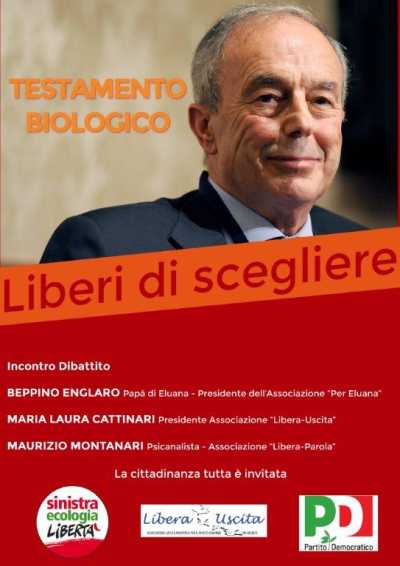 3.652. Sono i giorni passati da quel 9 febbraio 2009 in cui Eluana Englaro è stata uccisa. Dieci anni esatti.
3.652. Sono i giorni passati da quel 9 febbraio 2009 in cui Eluana Englaro è stata uccisa. Dieci anni esatti.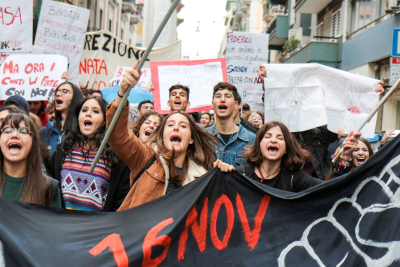 Da varie parti giunge notizia di inviti da studenti delle scuole secondarie alle più disparate associazioni, prime tra tutte quelle della galassia LGBT (1).
Da varie parti giunge notizia di inviti da studenti delle scuole secondarie alle più disparate associazioni, prime tra tutte quelle della galassia LGBT (1).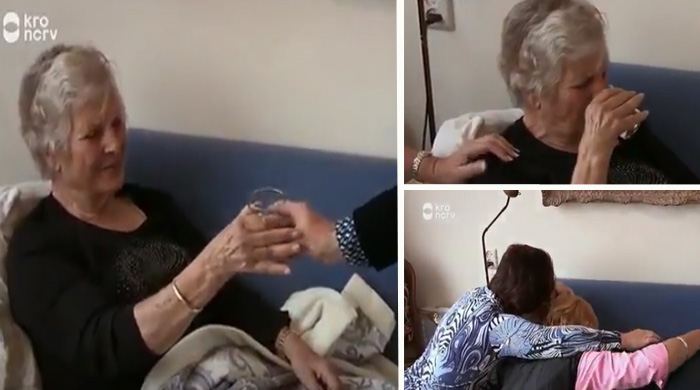 Accettata l?eutanasia ne consegue che il problema si sposta solo al quando.
Accettata l?eutanasia ne consegue che il problema si sposta solo al quando.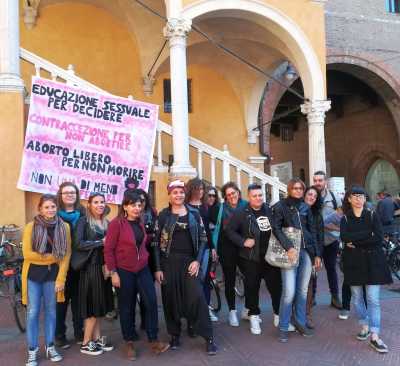 Ferrara. La “imponente” manifestazione contro la maternità e le mamme in difficoltà fatta dal Comitato “Non una di meno”: vale a dire che tale Comitato è composto da 14 persone, non una di meno.
Ferrara. La “imponente” manifestazione contro la maternità e le mamme in difficoltà fatta dal Comitato “Non una di meno”: vale a dire che tale Comitato è composto da 14 persone, non una di meno.
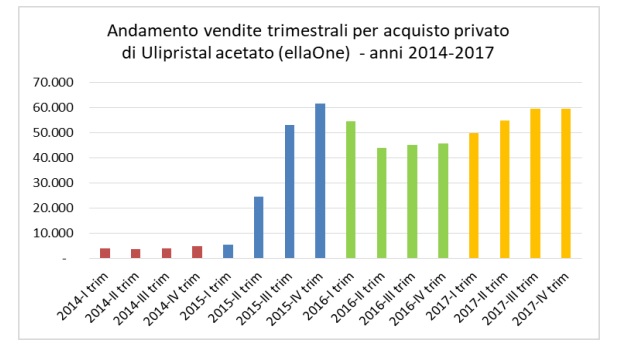 Il ruolo crescente delle pillole “del giorno dopo”, spesso abortive: tra il 2015 e il 2017 le vendite sono praticamente raddoppiate.
Il ruolo crescente delle pillole “del giorno dopo”, spesso abortive: tra il 2015 e il 2017 le vendite sono praticamente raddoppiate.
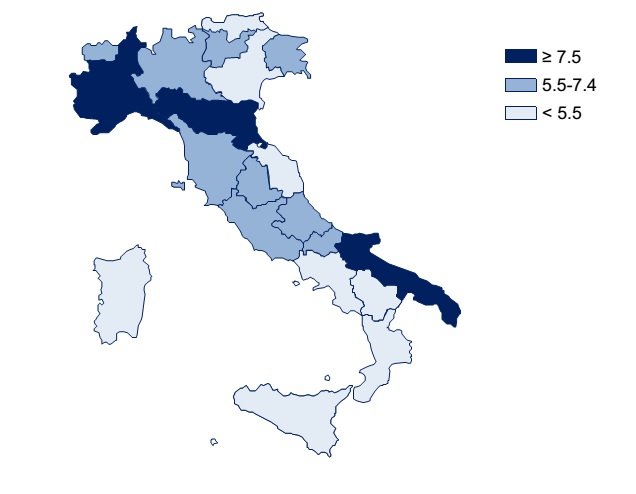 Le Regioni peggiori: Puglia, Liguria, Emilia-Romagna e Piemonte.
Le Regioni peggiori: Puglia, Liguria, Emilia-Romagna e Piemonte.
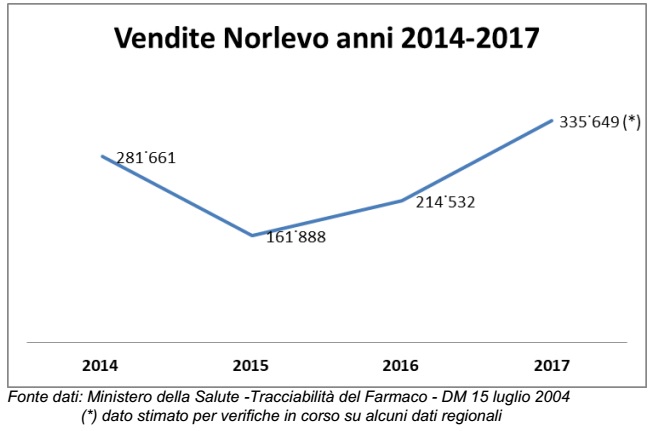 Pillola (spesso abortiva) dei 3 giorni dopo (Norlevo): dopo la liberalizzazione c’è stato un boom di vendite.
Pillola (spesso abortiva) dei 3 giorni dopo (Norlevo): dopo la liberalizzazione c’è stato un boom di vendite.
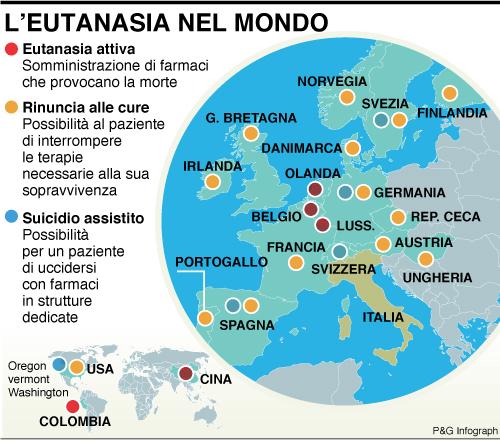 Il 5 febbraio è stato sottoscritto da molte realtà religiose, cattoliche e non, il «Manifesto interreligioso dei diritti nei percorsi di fine vita», che ha il grande limite di non vietare esplicitamente l?eutanasia, pratica che non è mai rispettosa della dignità personale. Un secondo aspetto molto problematico di questo documento è il modo fuorviante in cui viene intesa la libertà religiosa.
Il 5 febbraio è stato sottoscritto da molte realtà religiose, cattoliche e non, il «Manifesto interreligioso dei diritti nei percorsi di fine vita», che ha il grande limite di non vietare esplicitamente l?eutanasia, pratica che non è mai rispettosa della dignità personale. Un secondo aspetto molto problematico di questo documento è il modo fuorviante in cui viene intesa la libertà religiosa. Richiama l?attenzione il fatto che Nostro Signore Gesù Cristo, nella Storia Sacra, ha voluto Lui stesso salire al Cielo alla vista degli uomini e poi ha voluto pure che l?Assunzione della Madonna in Cielo accadesse davanti agli occhi degli uomini. Perché questa Ascensione e poi questa Assunzione dovevano avvenire in questo modo?
Richiama l?attenzione il fatto che Nostro Signore Gesù Cristo, nella Storia Sacra, ha voluto Lui stesso salire al Cielo alla vista degli uomini e poi ha voluto pure che l?Assunzione della Madonna in Cielo accadesse davanti agli occhi degli uomini. Perché questa Ascensione e poi questa Assunzione dovevano avvenire in questo modo?